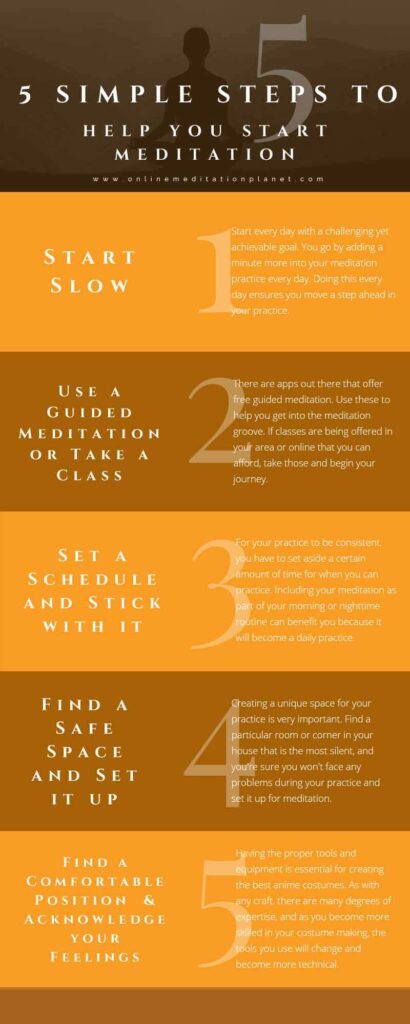It can be challenging to start meditation for a beginner simply because it needs consistency and focus. But once you’ve started, going on from there is easy. Recently meditation has risen to popularity due to its benefits on mental health. The practice of meditation has increased in the U.S as people try to find an easy and natural way to deal with the ever-growing daily stress.
Meditation is a simple practice that is available to all. Meditation is the use of techniques to encourage a heightened sense of awareness and increased focus. Meditation doesn’t stop you from thinking or encourage your mind to wander, but rather, it helps you realize patterns of thinking within yourself and learn more about yourself, leading to change.
Meditation can be quickly learned and practiced at the comfort of your own home. It might take a bit of time to find the perfect type of meditation since there are multiple of them out there, but once you do, you’re all set.
Studies have shown that meditation helps in reducing stress and anxiety. So if you’ve been thinking about starting this practice, there is no better time than now. It doesn’t matter why you’re beginning meditation, all you can be assured of is that as you progress, your perspective of life changes, and you’ll become a calmer person.
Article Contents
So, How Do You Start Meditation for Beginners?
Meditation isn’t one pill that cures it all, but it can help you in significant parts of your life. Sometimes this practice is all we need to calm down and make better decisions in our lives. Essential tools that you should not forget to bring to your practice are patience and compassion towards yourself.
To start meditation for beginners, you have to understand that the most important thing when it comes to meditation is to sit and practice. As long as you’re comfortable and your eyes are closed, stay focused on your breathing. This could be easy for some and hard for others.
You can’t be bad at meditation; all you can improve on is concentration which takes a bit of practice. Once you’ve mastered this, then you’re all set. Please take notice of every time your mind wanders and bring it back to your breathing. That is the only you can get better in practice. And if you need a little help, check out some online meditation classes.

Can You Teach Yourself How To Meditate?
The short answer is yes! You can teach yourself meditation. To do this, you can conduct your research on different types of meditation, choose one you feel most comfortable with, and start practicing.
The most accessible types of meditation to teach yourself are; body scan, mindfulness, and walking meditation. These types of meditations can quickly help you ease into the practice.
How Long Should Beginners Meditate?
The key to consistent meditation is starting small. As a beginner, you can even start with a minute as you move up. Even a minute can feel like a very long time to sit in silence when you’re a beginner. But with time, you’ll be able to move up to even twenty or thirty minutes at a time.
As a beginner, meditation might feel like self-inflicted torture but trust me, as you keep sticking with the practice, it will feel less like torture and more like fun. You’ll start asking, “how long can I meditate?” and that is the beauty of the practice.
The key to extended periods of meditation is sticking to meditating every day. It doesn’t matter if you’ve started with just a minute. Doing that minute daily for a week will start feeling like too short of a time, and you’ll upgrade to five minutes, and then some more.
1. Start Slow
It might feel a bit intimidating to start meditating at one-minute at a time, but that is better than forcing yourself to go for an hour straight on your first day. Start every day with a challenging yet achievable goal. You go by adding a minute more into your meditation practice every day. Doing this every day ensures you move a step ahead in your practice.
Going all in without preparation can be a bit overwhelming and isn’t sustainable. People who meditate for an hour at a time or more didn’t get there in a day. So, savor the journey.
2. Use a Guided Meditation or Take a Class
Don’t be ashamed to have some help. I’m sure most of us started meditation through guided ones (I know I did). There are multiple apps out there that offer free guided meditation. Use these to help you get into the meditation groove, and if with time it doesn’t work out for you, you can now move to music or silence.
If classes are being offered in your area or online that you can afford, take those and begin your journey. As long as you like the technique and you feel better afterward, that’s all that matters.
Participating in a class, whether online or physical, will help you with accountability and guidance. Some of these meditation apps count days you have practiced and days you missed, and most days, you’ll meditate even for five minutes to prevent yourself from flopping.
3. Set a Schedule and Stick with it
For your practice to be consistent, you have to set aside a certain amount of time for when you can practice. Including your meditation as part of your morning or nighttime routine can benefit you because it will become a daily practice, and that’s what we want. When you make meditation a habit rather than a choice, your day will be incomplete without it.
A perfect time to meditate is when you have the time. So, don’t squeeze meditation unnecessarily into your schedule, but rather, make sure you’ll have enough time to practice it, and you won’t have tasks waiting for you that will disrupt your mind.
If you set a schedule, it will help you meditate even when you don’t feel like it. A 2018 study found out that meditating daily for fifteen minutes promoted positive wellbeing and lower stress levels. The study also suggested that daily meditation has the same effects as taking a vacation.
4. Find a Safe Space and Set it up
Creating a unique space for your practice is very important. If you’re afraid that your phone may ring, your food might burn in the oven, or someone might enter the room you’re in, it might be hard to keep your mind from straying during meditation. Make sure you sort these out before your practice, light candles or incense to soothe yourself, and you could even bring a fuzzy blanket with you. Make sure you’re at ease when you’re beginning your practice to make things easy for yourself.
Find a particular room or corner in your house that is the most silent, and you’re sure you won’t face any problems during your practice and set it up for meditation. Setting it up could include; a soft light, a meditation cushion, some plants, candles, or whatever it is that helps you get in a meditative mood.
Whichever room or corner you use, you can keep adding items that’ll help it feel more like your sacred spot with positive vibes.
5. Find a Comfortable Position and Acknowledge your Feelings
A lotus position is the most common meditative posture. But you can twerk it to suit your needs. It would help if you didn’t sit in an uncomfortable position as it will be to meditate. Your comfort comes first.
As you meditate, breathe naturally, and focus on the sensations that arise as you do this. As you practice, the mind tends to wander off, bringing negative emotions and feelings. You should not beat yourself up for this but instead recognize them and push them aside as you go back to concentrating on your breathing.
Be kind to yourself no matter what you experience in your practice. Just like exercising, some days will be more complex than others depending on the amount of stress you’ve been through throughout the day or week. Be kind, and forgive yourself and remember that every day will be different.
Common problems you might face when you first start meditation
- Sleepiness. When you first start the practice, you might feel sleepy either because of over-stimulation or tiredness. There are different ways you can prevent this from happening. For example, you can try walking meditation, concentrate on music rather than breathing, or follow your breath from your nose down, your nostrils, to the diaphragm and back. Whatever works for you, please do it. Don’t just quit.
- Self-criticism. We are the most prominent skeptics of ourselves. You might feel at times like you’re doing it wrong, or you’re having a hard time concentrating. Don’t beat yourself up. Remember that this is a practice, and the more you do it, the more you’re able to quickly realize when your mind wanders and bring it back to your practice. Be kind to yourself in this journey.
- Pain. As you progress into more extended meditation periods, you might experience cramps in your legs or back due to sitting for periods at a time. Recognize these feelings and let them pass like any other feeling. If the pain prevents you from meditating, you can then alter your position to ease it.
- Restlessness. We are so used to the “busy” culture that it can be a little hard to sit still. If you’re feeling restless, concentrate on controlling your breathing. Take short in-breaths and longer exhales. This will help bring your concentration back to the present.
- Fear. If you feel fearful during your practice, concentrate on the physical sensations. Such as the wind touching your skin or sounds or air going in and out of your nose. Don’t pay too much attention to what’s causing you to be afraid. If it’s too intense, you can open your eyes or take a break.
Final Words
Meditation is a beautiful practice that everyone should enjoy. If you’ve been thinking of starting the practice, don’t be shy and start right away. All you need is yourself. Do this not only for the mental health benefits but for a deeper relationship with yourself. As you keep growing in this journey, you will fall in love with yourself, life and be more loving to every creature.





